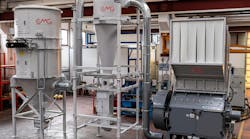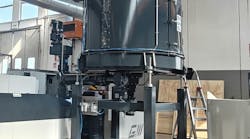With nearly 30 years in the plastics industry under his belt, Adrian Merrington has witnessed a shift from a focus on mechanical recycling to a mindset that takes products’ entire life cycles into account. Merrington serves as business quality leader for engineered materials, compounds and blends at Trinseo LLC, a global supplier of plastics, latex binders and synthetic rubber that has a portfolio of resins made with recycled content.
Recognized for his passion for education and research in plastics recycling and sustainability, he served as technical chair of the Recycling Division of the Society of Plastics Engineers (SPE) until earlier this year and is a 2021 recipient of SPE’s Honored Service Members Award. He has been involved with SPE for 27 years. He spoke with Plastics Machinery & Manufacturing Associate Editor Kathy Hayes. A version of this interview appears in the fall issue of Plastics Recycling.
How long have you been with Trinseo?
I am a business quality leader for engineered materials, compounds and blends. I joined Trinseo in 2017 after a short period with a Midland-based recycler, but the majority of my career had been as a researcher at Michigan Molecular Institute (MMI) before it closed its doors in 2015.
How many years have you been in the plastics industry?
I graduated with a Ph.D. in chemical engineering from the University of Bradford in England in 1992 and immediately began my career in the plastics industry when I joined MMI in the spring of that year. My focus at MMI had been in recycling and compounding plastics with particular focus on the needs of the U.S. automotive industry. I was CTO in an MMI co-venture that produced bio-based fillers for use in the plastics industry, and [I was] research director as [an] MMI collaborator for numerous recycling companies.
Where are the biggest opportunities for growth in plastics recycling?
The infrastructure behind the collection of plastics for recycling continues to be a major limiting step. Availability, transportation, costs, willingness of local authorities to fund or subsidize collection remain roadblocks.
Plastics’ shining example for a circular economy still most likely lists PET as the best example of a successful recycling program. That bottle-bill states significantly outperform unregulated states in collection and availability of PET bottles shows the importance of infrastructure. If we truly want plastics recycling to succeed, there must be an opportunity to recover used materials. Instead, we often see plastics recycling cut as a cost-savings measure by many local authorities.
Developing/establishing the infrastructure to recover used plastics remains an opportunity to ensure growth in all plastics recycling processes. Developing methods to reuse plastics helps but only if we can get the plastics to reuse.
What do you see on the horizon that’s exciting for plastics recycling and sustainability? What’s the next big thing?
I think the next big thing is where the business is moving. Most traditional recyclers up until recently were mechanical recyclers focused on primary and secondary recycling processes: recover plastic, grind it up and reuse it in either the same part (primary) or in parts with less-demanding property requirements (secondary).
The shortcoming of these types of processes is that the plastics undergo degradation from, e.g., chain scission during processing of thermoplastics; that means they can generally only be used as a percentage of the recycled content and reused a limited number of times before properties are no longer maintained. Some plastics are more susceptible to chain scission so the ability to recycle cycle after cycle is diminished.
The influx of interest from large plastics companies in sustainability has stimulated focus in tertiary recycling opportunities where plastic waste is used as the feedstock in processes that generate chemicals, such as monomers or oligomers, or fuel. These chemical building blocks, recovered by such techniques, are used to produce recycled-content plastics with virgin-equivalent properties not typically achievable in primary and secondary recycling processes. By generating monomers or oligomers, these tertiary recycling processes are not susceptible to the decreasing properties exhibited by mechanically generated recycled-content plastics. Enabling a cycle-after-cycle product that maintains properties is the only way to ensure a circular economy for plastics.
You’ve been involved in the SPE Sustainability Division for a long time. How has the conversation about sustainability changed?
Well, the group has changed its name a lot. When I joined the group, it was the Recycling Division with focus on both recycling and bioplastics. Then, to better reflect the activities of the group, it became the Sustainability Division. As bioplastics formed its own division within SPE, the focus of the original group reverted to mechanical recycling and the division re-established its traditional name. SPE now has a Recycling Division again, in addition to a Bioplastics Division and a Sustainability VP in Conor Carlin.
I think that evolution of names also mirrors how the conversation has changed. It’s no longer just about mechanical recycling or bio-based plastics, but looking at the full life cycle of materials and how they’re used and perceived.
Plastics gyres were entering the public’s consciousness a couple of decades ago, but the relatively recent inclusion of concerns over microplastics in the environment needs to be addressed with science to counter some of the emotive arguments. Single-use plastics bans in food and grocery industries, geographical bans from countries that used to take North American plastics scrap … the Basel initiative to limit transportation of plastics scrap, etc. are dominating the conversation.
Plastics are completely unique in some of the opportunities they offer, yet the public often has a dim view of the industry. That misconception originates mostly from the waste generated after use. The issue is a waste-disposal issue, but the plastics industry is in the public’s eyesight. And for too long those of us within the industry have shied away from any responsibility, giving an opportunity for anyone with opposing views to promote unchallenged and unfounded observations. I think we’re learning that we can’t say to the public, “it’s you guys that throw the stuff on the ground, not us” and think that’s good enough.
How did you get interested in recycling and sustainability?
My Ph.D. research was in the rheology of colloids. That may seem like a distant connection to plastics recycling, but it was the study of how dissimilar entities interact and how surfactants can be manipulated to influence the interaction.
I was offered the opportunity to collaborate on a National Science Foundation-funded project to look at recycling comingled domestic scrap — again how dissimilar entities interact and how compatibilizers can be used to improve interfacial interaction. There isn’t a lot of difference between surfactants and compatibilizers conceptually. From there, I spent less and less time worrying about rheology and more and more time focused on how to ensure that valuable plastics were not buried in landfills.
What role do resin suppliers have in increasing recycling?
I think that many of the big names in resin supply are accepting the opportunity to ensure plastics’ sustainability. Twenty years ago, I sat in the offices at a major resin supplier who told me that they didn’t see value in recycling plastics, as anything that was recycled meant they couldn’t sell new product in its place.
Whether pushed or pulled into acceptance, there is a significant movement towards sustainability from resin suppliers. Some of the biggest name brands no longer accept low bids as the only reason to buy plastics from a producer and are demanding sustainable production.
And it’s working. As I mentioned earlier, the influx of interest from large plastics companies in sustainability has stimulated focus in tertiary recycling opportunities where plastic waste is used as the feedstock in processes that generate chemicals, such as monomers or oligomers, that are used to produce recycled-content plastics with virgin-like properties. That investment of resources (time, people, money) just wasn’t there a decade or so ago. Now, it’s seen as a differentiator.
What are the biggest challenges that are holding plastics recycling back?
Infrastructure and legislature. If we want to see plastics recycled, there has to be a means by which they are recovered and available in the locations where the recyclers exist.
Is there anything else you would like to share?
If your business involves plastics or plastics recycling, it’s not enough to sit on the sidelines anymore. There are too many voices that are increasing in volume that offer counter arguments to the existence of your business. Join a group like SPE that continues to do an excellent job providing science-based arguments against emotive-driven opinions.
Name, title: Adrian Merrington, business quality leader
Company, tenure: Trinseo LLC, four years
Home base: Midland, Mich.
Years in plastics recycling industry: 29
Degrees: Bachelor of Science in applied chemistry from the University of Greenwich; Ph.D. in chemical engineering from the University of Bradford






